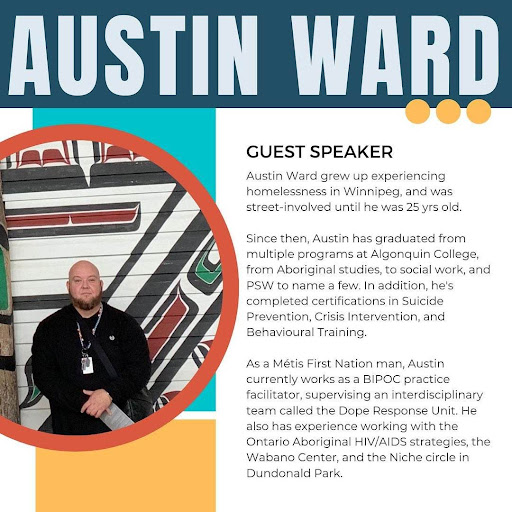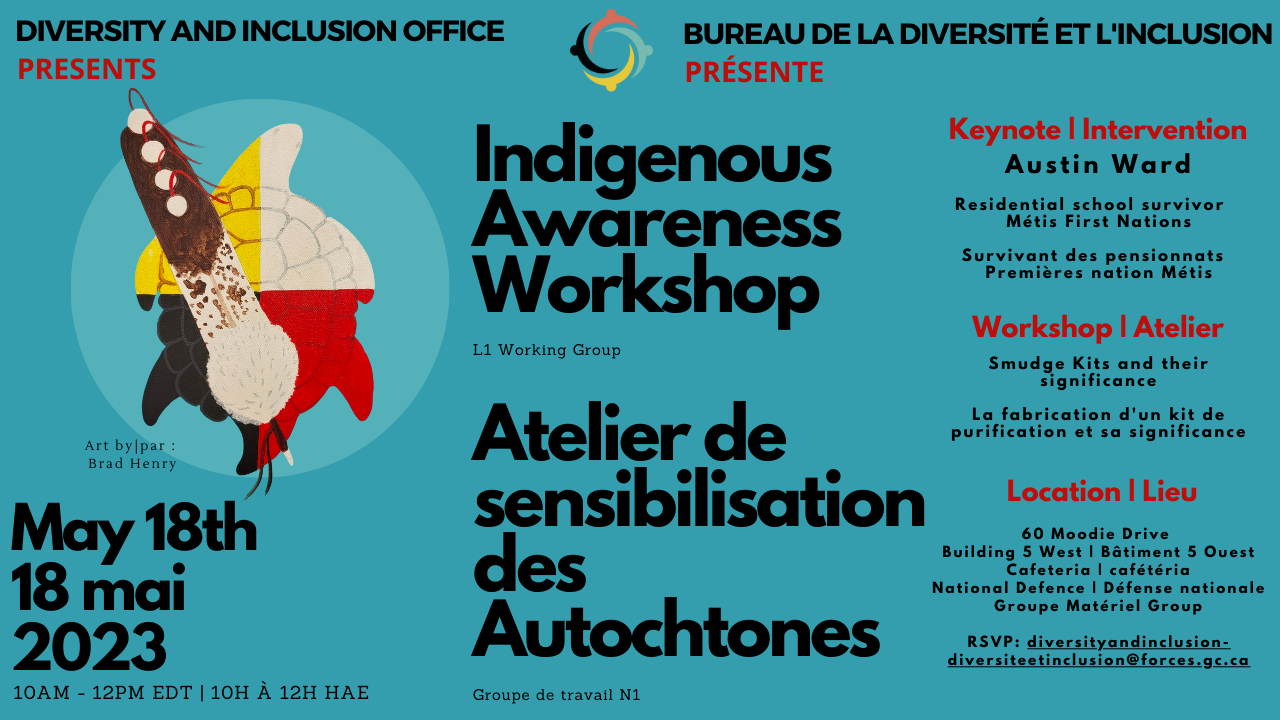Difference between revisions of "Atelier de sensibilisation des Autochtones en vedette Austin Ward"
| Line 4: | Line 4: | ||
== A propos de l'événement == | == A propos de l'événement == | ||
| − | Austin Ward | + | Austin Ward animera un espace de partage sur les croyances des cercles autochtone et enseignera aux membres comment fabriquer un kit de purification et sa signification. Austin animera également une séance de questions-réponses de 30 minutes avec la chef de section, Samantha Moonsammy, afin de partager ses expériences vécues et ses idées sur la manière dont nous pouvons faire de la diversité et de l'inclusion une priorité dans notre vie quotidienne, au travail et au sein de nos communautés. |
== À propos d'Austin Ward == | == À propos d'Austin Ward == | ||
Revision as of 08:16, 26 April 2023
A propos de l'événement
Austin Ward animera un espace de partage sur les croyances des cercles autochtone et enseignera aux membres comment fabriquer un kit de purification et sa signification. Austin animera également une séance de questions-réponses de 30 minutes avec la chef de section, Samantha Moonsammy, afin de partager ses expériences vécues et ses idées sur la manière dont nous pouvons faire de la diversité et de l'inclusion une priorité dans notre vie quotidienne, au travail et au sein de nos communautés.
À propos d'Austin Ward
Austin Ward is a Métis First Nations man from Manitoba who was raised by his Mohawk father. His father taught him how to hunt, fish, and set up trap lines while emphasizing the importance of honoring the animals that gave their lives to feed their families and community. However, when Austin went away to residential school for two years, he returned to find that his father no longer wanted to teach him the traditional ways. This caused Austin to resent his Indigenous culture and eventually led him to become street-involved in Winnipeg.
Despite his troubled past, Austin decided to make a better life for himself and his son by moving to Ontario and attending Algonquin College. He successfully graduated from multiple programs, including General Arts & Science, Social Work, PSW, and Aboriginal study Victimology, Autism, and Behavior studies. He also obtained many certificates in Suicide Prevention, Crisis Intervention, and Behavioral Training. As a Métis First Nations man, Austin currently works as a BIPOC practice facilitator and supervises an interdisciplinary team called the Dope Response Unit. He also facilitates a Niche circle in Dundonald Park and has given talks on how to break the street life cycle.
Austin reconnected with his teachings and culture by getting involved with his knowledge keepers and now carries a Bundle with pride. He teaches about the four traditional medicines - Sage, Tobacco, Sweetgrass, and Cedar - and how they are used in smudge kits. He emphasizes the importance of handling these medicines with good intentions and making smudge kits with good thoughts. Despite his troubled past, Austin has become a role model in his community and is helping others to reconnect with their culture and teachings.
Sage, tobacco, sweet grass, and cedar are the four traditional medicines used in smudging ceremonies. Each of these medicines has unique properties and purposes.
Sage is commonly used for cleansing negative energy and purifying a space or person. It has a strong, distinct aroma that can help clear the mind and promote mental clarity. Sage is often used at the beginning of a smudging ceremony.
Tobacco is a sacred plant used for offering prayers and thanks to the spirits. It is often offered in gratitude for the gifts of the earth and for protection during spiritual ceremonies. Tobacco can be smoked or offered in a pipe during smudging.
Sweet grass is a fragrant grass that is burned as a purifying agent to attract positive energy. It is commonly used to create a welcoming and peaceful atmosphere, and its sweet scent is believed to invite positive energy and spirits.
Cedar is used to purify the mind and body, and to help restore balance and harmony. It is often used in healing ceremonies and is believed to have powerful cleansing and protective properties.
When creating smudge kits with these medicines, it's important to handle them with respect and care. The intentions behind the smudging ceremony should be pure and positive, and the smoke from the burning medicines should be used to cleanse and purify the space or person.
Thank you for letting me share this insight into Indigenous circle's beliefs. It's important to recognize that there may be different beliefs and practices within Indigenous communities, and that they are all valid and rooted in cultural traditions. It's also important to acknowledge that addiction and substance use disorder can be a complex and challenging issue, and that different approaches and strategies may be needed to address it. The use of traditional medicines and practices, such as smudging, can be a helpful tool in supporting healing and wellness for individuals and communities, but it's important to approach them with respect and understanding of their cultural significance.


